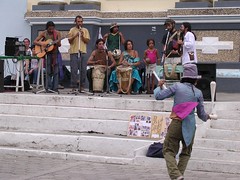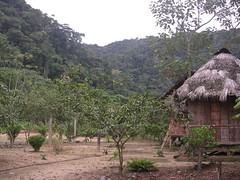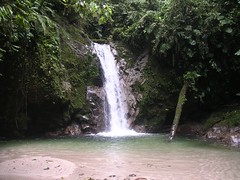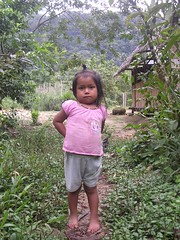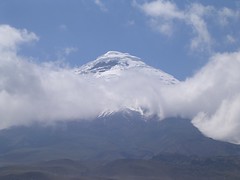When our German friends wake us up, soon in the morning, we begin the travel from Vilcabamba towards the frontier between Ecuador and Peru. Our route, passing through the village of Zumba, follows an off the beaten track. After a pass that dominates the valley of Vilcabamba, we begin a long descent through the mountain jungle of the Podocarpus National Park. The bus makes frequent stops, often in ghost villages, but there are always people who wait for our arrival; shortly we are swept up by a mass of people, goods and animals. After approximately 6 hours of travel we reach Zumba, the first half of our itinerary. Nearly 2 hours of camioneta separate us from the Peruvian border, but a bridge swept in a blaze by the river forces us to wade: the adventure gets more and more interesting! It’s already evening when we get our passports stamped, by the international bridge of La Balsa. 2 more hours of colectivo (dispelling any doubts of other travelers: 12 soles, negotiable till 10) and we arrive in San Ignacio, tired but happy… We leave Ecuador, a very small Latin American country that has given us many unforgettable experiences and the hope that there can be a future, when people have the courage to fight for their own rights. Now Peru, a giant for beauty and history, the crib of the Inca civilization.
Vilcabamba, the eternal youth
After a short staying in Cuenca, third city of Ecuador and famous for its university, we go on with our travel that is everytime more nomadic and itinerant. Now our goal is Vilcabamba, a very small pueblo next to the Southern border with Peru. The mystery which wraps this village from the eternally vernal climate, it’s the longevity of its inhabitants. Effectively we are astonished to meet so many old and brilliant men, but as the record of Vilcabamba is on everyone’s lips, probably many people declare more years of their actual age… Meanwhile we spend a nice Sunday with music and “malabarismo” (juggling) performances, by the group of artists Pacha Feria.
Tungurahua, bloqueos and Ingapirca
Going through a dirty road from the Amazonian river basin, we return on the Andean Altiplano; and the emotions quickly involve us. We assist from far away to the explosive eruption of the Tungurahua, just a few weeks after our staying in Baños (at the slopes of the volcano). We participate to the bloqueo of the Panamericana in true Latin American style and for some hours we integrate with the people of a very small village and its problems. After a short staying in Riobamba, defined “Sultan de los Andes”, we head to Cañar. From there, an old bus takes us near the Inca ruins of Ingapirca. Beyond the historical interest, we discover a charming place, inhabited by simple and nice people, where finally we can caress some llamas, the famous Andean camelids, that rest near the archaeological site.
From Coca to Iquitos
One of the most adventurous ways to travel from Ecuador towards the Peruvian Amazonian rain forest is to cruise along the Rio Napo, embarking on the cargo boats that follow the route Coca (Equador) – Iquitos (Peru). We have been attracted by this adventure for a long time, but the extreme uncertainty on delays and distances, has forced us to renounce. This is the information we have collected, hoping it can be useful for other travellers. Coca is situated in the North-Eastern region of Ecuador and there are three ways to go there:
- Quito-Coca, 12 hours of direct bus.
- Quito-Tena-Coca, with a stop in Tena (rafting, canyoning, kayaking, ecotourism in the Amazonian forest).
- Quito-Baños-Tena-Coca, with a stop in Baños for trekking and thermal baths.
Coca, a rainy city born as base for the explorations of the oil companies, it’s the place where all the roads end, the travel continuous on the cargo boats along the Rio Napo: near the port of Coca you will look for a boat going to Nuevo Rocafuerte, officially supposed to leave on Mondays and Thursdays, but there could be others. Meantime, it’s necessary to get your passport stamped at the immigration office (the last one before Ecuadorian border). The travel until Nuevo Rocafuerte lasts approximately 12 hours, but could be interesting to program a stop along the way (Limoncocha for example): it’s one of the wildest zones of the Amazon, for a long time the Rio Napo borders the Yasunì National Park, where Huaorani, Tagaeri, Achuar and Siona isolated indigenous groups still live. We advise to contact a local guide before your arrival. From Nuevo Rocafuerte, you should find a canoe to Pantoja, the first village in Peruvian territory, where it’s possible to get your passport stamped. From Pantoja the hardest part of the travel begins: four or five consecutive days by boat, until the city of Masan, from where other travelers suggest to take a moto-taxi to a port of fast lanchas (canoes) directed to Iquitos, in order to save 13 hours of boat trip.
Probably a long and debilitating travel, to be undertaken with a lot of calm in order to know a wonderful part of Amazonian forest, surely an adventure.
Ecotourism in the Amazon
Ecotourism, communitarian tourism, ecolodges, ecoresorts are just many names which refer to the same experience: coming in contact with the rain forest and the people (aboriginal peoples) that inhabit it. In the case of the Amazon, because a good part of its future goes necessarily through this type of tourism, we want to give some suggestions, fruit of our experience. Firstly, you should consider that it’s difficult, if not impossible, the integration in the indigenous communities of the forest, there are too many differences. The only way to try a deeper approach to this world it’s to go there as volunteer (voluntourism): in this case better to get information in Quito on the options available, remembering that usually the period of cooperation is at least 3-6 months and that often the volunteers are asked to pay in order to cover expenses and registration fee. If instead you are travelers or tourists, our suggestion is to directly go to one of the cities/entrance gate towards the Amazon (in the case of Ecuador: Tena, Puyo, Macas, Coca or Lago Agrio) and spend there some days, trying to get information or better to know a person able to indicate you the communities that receive visits in the forest. A smart trick is to go to the travel agencies which offer organized tours and ask for their destinations; sure they will deny, but you will always be able to find a passage by bus, canoe or taxi towards the same place. Currently, Kichwa communities in the region of Tena (Napo) offer lodging in wooden cabañas and food for approximately 10 dollars a day. In this case, what you will be able to see is limited to the nearest attractions, unfortunately it’s impossible to explore the forest as independent traveller. Therefore, you’ll have the problem to find a guide who could accompany you in the remote places. After all, especially in the event your group isn’t numerous, it would be better to buy an organized tour by any travel agency, maybe after verifying that your money will be used for the development of the community itself. Last consideration: locals always deny, but tropical diseases exist (dengue, malaria, etc)… avoiding paranoias, take necessary precautions.
For many travelers the ecotourism in the Amazon it’s just a waste of time and money, but with an intelligent approach, it could transform in an opportunity to know and help to preserve one of the most incredible ecosystems of our planet.
Last shamans of the Amazon
Sarita and Carlito accompany us through this experience, teaching the language of a world we didn’t know before, the keys in order to understand and respect the forest. They design in our minds the symbols of nature: the anaconda (amaru), the boa, the sangre de drago (dragon blood, a medicinal resin), the butterflies, the curative plants used by the community and the shamans. Ayahuasca (the word which means “vine of the spirits” in Quechua language) or yagé, is a traditional psychotropic infusion considered sacred by the indigenous peoples in all the river basin of the Amazonian forest. It comes prepared by the shamans or curanderos in infusion and it’s consumed by night, as an instrument to expand their own mind and perception of nature. In the Napo region, Equador, it’s known with three different names:
- Ayahuasca de las Mujeres, visions of flowers.
- Ayahuasca de los Hombres, visions of boas.
- Ayahuasca de los Fantasmas, visions of spirits.
An Amazon indigenous community
Sinchi Sacha means “strong forest” in the Kichwa indigenous language. Carlito, our young guide, knows every centimeter of his world, the forest; with his machete opens a way that knows by heart, he follows the “songlines” traced by his ancestors. While we listen to the fascinating lesson on the animals, trees and medicinal plants, we exceed crystalline water torrents, vine forests, mariposarios (humid cliffs where the tropical butterflies flock together) and we reach fabulous cascades dipped in the luxuriant jungle. After walking for hours we lose the orientation: the snazzy colors of the flowers, the infinite shades of green, the cries of the animals, the sound of the rain falling on the leaves, the humidity smell that every minute becomes deeper and wilder… an outbreak of emotions that take shape and dissolve in the palette of a painter, in the symphony of a single artist: the nature in all its strong creativity.
Tena, a look to the Amazon
Now we are really in the Amazon basin… to make it clear, there are the curious smiles of the children who run towards the bus. In their black eyes and smooth like silk hairs, it’s hidden all the mystery of these wild places. Here humans continue to be just simple appearances, while nature shows itself exuberant and tenacious. Therefore, it’s a world that comes out from ancestral memories: we caress a boa and we perceive its uncontrollable power, we play with some monkeys and we perceive their likeness. Our friend, Gabriel, is a sturdy but pleasant man, son of the forest, born in a Kichwa (Quichua) indigenous community: he seems to have many stories to tell and a slight nostalgia for a world that inexorably goes away and refuses him. Tena is a city which denies the idea itself of the Amazon rainforest, even though it’s totally embedded in the jungle. Meanwhile it’s raining, raining and raining…
Baños hot springs
Baños is a small city which rises in a flat piece of land, where the Andean valleys begin their tortuous descent towards the Amazon basin… we get there leaving the Pan-American highway near Ambato, city center of one of the most colored carnivals of Latin America (“fiestas de las flores y las frutas”). In the subtropical climate of Baños meet all the forces of nature: the Tungurahua volcano that dominate the village and it’s currently in eruption, frequent earthquakes, some impressive cascades and the clouds that incessantly thickens on the flanks of the mountains. In reason, the inhabitants of Baños talk with emphasis about the last eruption of the Tungurahua (August 2006), when part of the pueblo was destroyed. However, several Ecuadorian tourists come here, attracted by the hot springs of warm and sulfurous water; we also find a pleasant place, where we have a good time before the breathtaking descent towards the Amazon river basin.
Cotopaxi National Park
Exactly in front of the bridge which is the entrance gate to the city of Latacunga, a young boy tell us to go up on its rickety bus. It’s early in the morning, we begin the travel towards the covered by snow and perfectly conical top of the Cotopaxi volcano. The road rises inexorably: three, four, five thousand meters, the landscape becomes even more impressive. The silence owns these windy places, lived by the only animals have been able to adapt to the hard Andean climate (alpacas, condors, pumas, wild horses). For a moment we dream to go up till the top of the Cotopaxi crater to dominate an exterminated horizon, but climbing the highest active volcano of the world is not an adventure that could be organized in five minutes… some horses, pride of their freedom, follow us suspiciously while we walk around the Limpiopungo lagoon. Three big condors of the Andes caress the lost in clouds peak of the Rumiñahui volcano, where a warm and blinding sun (the god Inti in the Incaic culture, indeed) tries to open itself the way in the foggy cover.
On the way back we pass near Saquisili, a village which is center of one of the most colored Ecuadorian markets, every Thursday.

